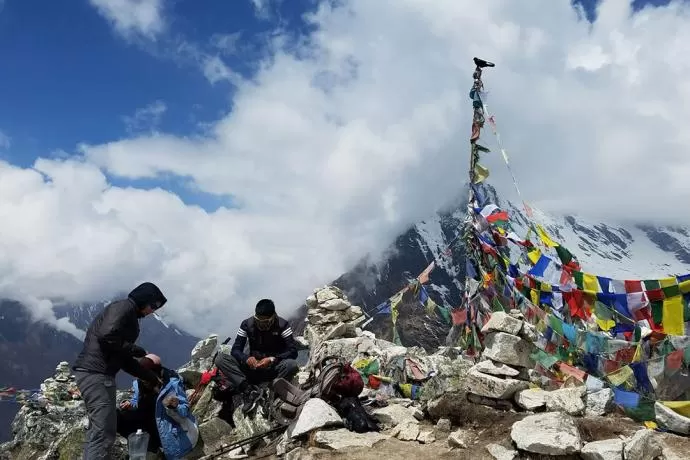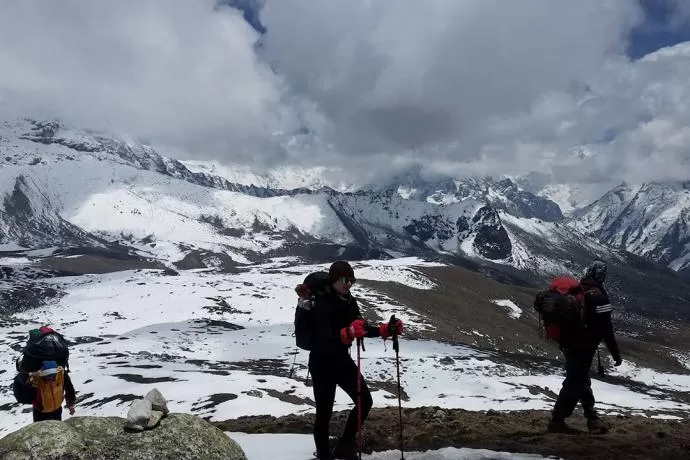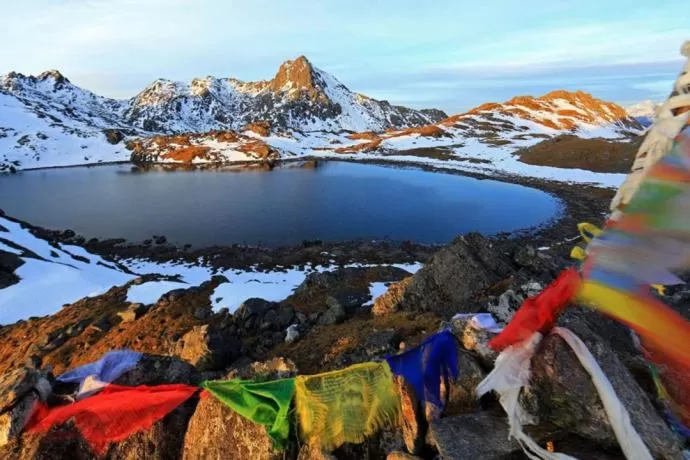Langtang Valley Trek
Situated in the Langtang region of Nepal, the Langtang Valley Trek is a popular trekking trail taking you through the region's diverse landscapes.
Full of natural landscapes, charming villages, and rich local culture, the trek is one of the nearest trekking trails from the city, offering magnificent sights of the snow-capped mountains.
The Langtang Valley trek is also known for its diverse flora and fauna, including rare species like the red panda, and further leads you to the highest viewpoint of the region, Tsergo Ri, at an elevation of 4984 m.
Relatively less crowded and short, the Langtang Valley trek is an excellent option for beginner trekkers. The trek usually takes around 6-10 days to complete, which depends on the itinerary and your walking pace.
Although there is one trail to complete the trek, you get to choose the length of the journey, as the trek can be customized according to your preference.
Keeping our client's preferences and safety foremost, we are here to guide you from the beginning to the end of the trip. Our team guarantees you a safe and enjoyable time throughout the journey, offering you an end-to-end service.
Traveller Photos for the Langtang Valley Trek
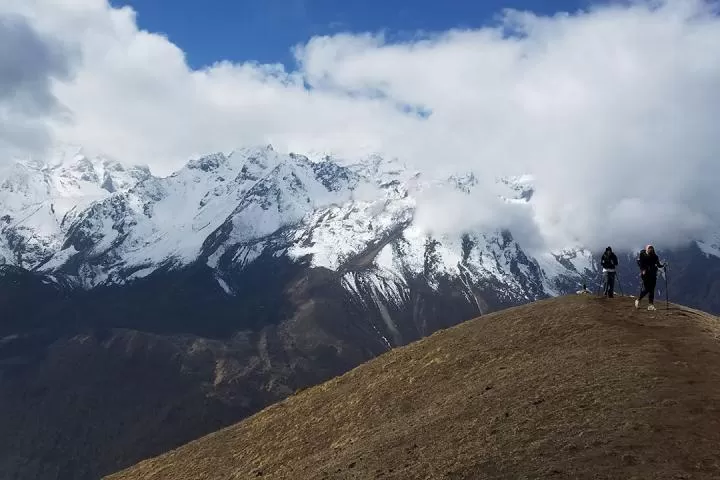
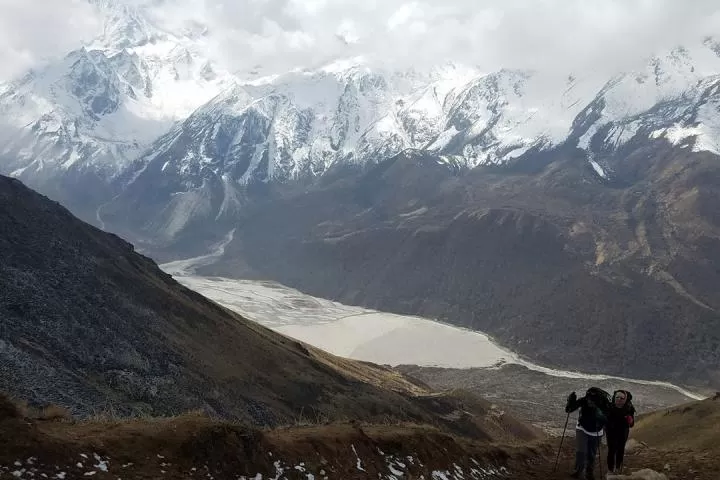
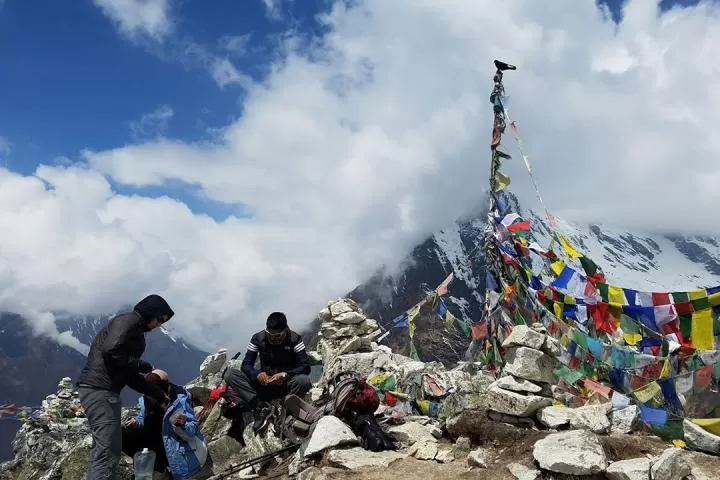
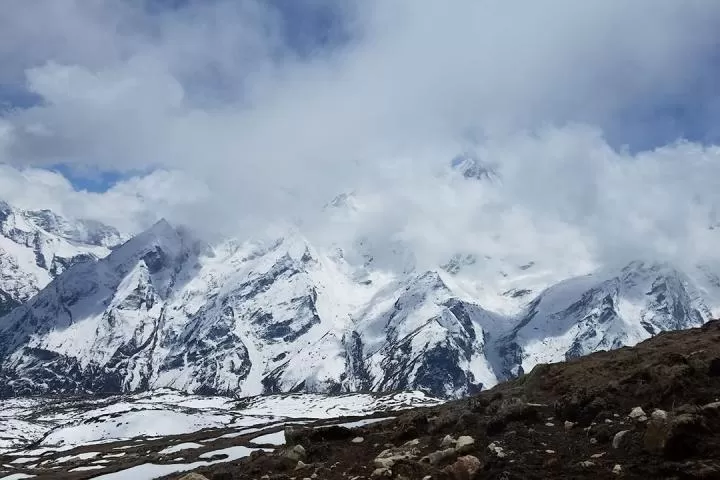
Langtang Valley Trek - Overview
Location: Langtang region, Langtang National Park, Nepal.
Duration: 6 to 10 days, depending on the itinerary.
Max Altitude: 4,984 meters (16,349 feet), Tsergo RI.
Transportation: Bus ride from Kathmandu - Syabrubesi- Kathmandu.
Starting Point: Syabrubesi.
Accommodation: Teahouses and lodges along the route with essential lodging and meals.
Best Time to Trek: The spring (March to May) and autumn (September to November) seasons.
Required permits: Langtang National Park entry permit and the Trekkers' Information Management System (TIMS) card.
Difficulty level: Moderate-grade trek, including ascending an altitude of over 4000 m.
Mountain sights: Panoramic views of mountains like Langtang Lirung, Ganesh Himal, and Langsisha Ri.
Cultural Experience: Close insight into the local Tibetan communities' culture, traditions, and lifestyle.
Physical Fitness: Good health condition with moderate physical fitness and stamina.
Safety: Essential to have rest in between the walks, the proper clothing, and travel insurance for a safe and pleasant trek.
Flora and Fauna: Diverse range of flora and fauna, including rhododendron forests, bamboo groves, and alpine meadows, along with rare sights of red panda, musk deer, langur monkeys, and various bird species.
Side Trips: Side trips in popular destinations of the region like; Gosaikunda Lake and Helambu trek.
Why Choose Us for the Langtang Valley Trek?
Exceptional background: We have years of experience in the travel industry with expertise in tour and trekking operations. With a guaranteed track record, we have established ourselves as one of the trusted names in the industry. Our numerous positive reviews from satisfied clients are a testament to our excellence.
Highly experienced guides: Our team has guides with extensive knowledge and experience navigating the Langtang Valley trail. With their years of professional expertise, you will have a safe and memorable journey.
Emphasis on clients' safety and satisfaction: Your safety and satisfaction are our top priority, and our team will ensure that the trek is completed by following the safety protocols and providing you with the best service and trip.
Availability of personalized trips: Considering that each traveler is unique and has their preference while traveling, we offer customized itineraries catering to your specific interests and timeframe.
Local Expertise: We take pride in promoting the Langtang Valley's natural beauty and cultural richness. Our guides have extensive knowledge of local culture, traditions, and lifestyle.
Eco-friendly travel: As responsible trekking operators, we are committed to practicing responsible tourism and giving back to the local communities we visit. We aim to maintain the trails, promote waste management practices, and support responsible trekking to preserve the region's natural beauty. By choosing us for your trek, you contribute to the well-being of the local people and their environment.
Authentic Cultural Experiences: As we have strong connections with the local community, you will get insights into the region's unique culture and way of life. Also, to provide you with an authentic and immersive experience, our itinerary includes a stay in local lodges and teahouses.
Availability of choices for routes: Whether you are an experienced trekker or a beginner, we offer various route options to cater to different fitness and preferences, ensuring a perfect match for every adventurer.
Pre-Trek Briefings: We offer pre-trek briefings to our clients to ensure that everything is well-prepared. You will be provided comprehensive information about the journey, allowing you to familiarize yourself with the trail ahead and have all your queries answered.
Competitive Cost with the best service: We believe in providing our clients the best possible service at competitive pricing. Thus, we offer a competitive price while not compromising on the quality and services of the trek.
Transparent and secure payment Terms: We ensure secure online transactions and provide clear and transparent terms and conditions for all our services regarding payment.
Commitment to Your Safety and Well-being: When you embark on the Langtang Valley Trek with us, your safety and well-being become our top priority, and we ensure a worry-free and memorable journey.
Personalized Customer Service: We take pride in our personalized customer service, catering to your needs and preferences. Focusing on your preferences and needs during the trek, our staff will go above and beyond to make your trekking experience exceptional.
What is the cost of the Langtang Valley Trek?
The overall cost of the trek to Langtang Valley gets affected by several factors. The cost can range from USD 700 to USD 1500 for a 7 12- days journey.
The cost usually includes charges for permits, accommodation, meals, guides, and transportation during the trek. Here we have listed some major elements affecting the cost of the Langtang Valley trek.
What factors influence the cost of the Langtang Valley Trek?
Trek duration: The total days it takes to complete the journey can affect the total budget of the trek. An increase in days means an increase in expenses and vice versa.
Time of the year: The season or the time you choose to trek can affect the total cost. As in peak season, the price can be increased because of high demand and vice versa.
Accommodation level: Different levels of accommodations are available along the trail, from basic teahouses to luxurious ones. The type of accommodation you prefer affects the total costs of the trek.
Group size: Trekking in Larger groups can reduce the total costs per person. At the same time, trekking solo can cost expensive.
Guide and porter services: You need to have a guide to complete the trek; however, it is different with porter. It is your choice to hire a porter or not, which affects the overall budget of the trek.
Extra meals and drinks: If you have extra meals and drinks during the trek except for the three-time meals (Breakfast, Lunch, and dinner) included in the package, you will need extra cost.
Equipment rental: If you do not have the needed equipment, you will have to rent the gears, which adds to the total cost of the trek.
Travel insurance: The package offered by us does not cover travel insurance. You will need extra costs for the comprehensive travel insurance.
Optional activities: Additional activities during or after the trek have their fees and are not included in the package price.
International travel expenses: The cost does not cover international flights, visas, and accommodation before and after the trek, and you will need separate costs for that, which can impact the total budget.
Tips and gratuities: Tipping guides, porters, and support staff during the trek can add to your total trek expense.
Currency exchange and ATM fees: Additional charges may apply when exchanging currency or using ATMs in remote areas along the trail.
Miscellaneous costs: A small amount should be set aside for unexpected circumstances or emergencies along the trail.
Additional accommodation and meals in Kathmandu: If you want to add a few days to your trip, the expenses for extra nights in Kathmandu add to the overall cost.
Side trips: Any side trips during the trek except the place mentioned in the itinerary are not included in the price and will cost extra.
Extra services like Wi-Fi and hot showers: In the high altitude of the trek, you might have to pay an extra charge for services like WIFI and hot showers affecting the total cost of the trek.
Helicopter evacuation costs (if needed): In case of emergency, helicopter evacuation should be done, which can be expensive, adding up to the total budget of the trek.
Souvenirs and shopping: Shopping for souvenirs during the trek can add up to the overall expense of the trek.
Cost of extra nights in teahouses or lodges: Additional nights spent in teahouses or lodges along the trail can add extra charges.
The Langtang Valley Trek is a relatively affordable way to experience the beauty of the Himalayas. By carefully considering the factors that can affect the cost of the trek, you can plan a trip that fits your budget and your needs.
Best time to trek the Langtang Valley Trek
The Langtang Valley trek is a moderate-grade trek with a short duration so that it can be completed throughout the year with proper preparation.
However, there are certain pros and cons of trekking in every season. And the best time to complete the journey is the spring season, from March to May, and Autumn, from September to November.
We have gathered all the information you need before embarking on the trek.
Autumn (September to November):
Autumn is considered one of the best seasons for trekking in the Langtang Valley. The weather is stable, with clear skies and moderate temperatures during this season.
The views of the mountains are magnificent during this season without any obstacles, and the changing colours of the landscapes further add beauty to the entire trail.
However, as one of the peak seasons, the trail usually gets packed in Autumn, and booking the lodges in advance is highly recommended.
Spring (March to May):
Spring is another excellent time for the Langtang Valley Trek. This season offers mild temperatures, blooming rhododendron forests, and clear mountain views.
The views of the mountains are usually clear, and temperatures are pleasant during the day, making it an ideal time for the trek.
However, as another popular season for trekking, the trails are most likely to be packed in spring as well.
Winter (December to February):
Generally, winter is not the right time to complete the trek in the Himalayan region of Nepal as the weather conditions are harsh, with extreme cold and heavy snowfall.
The trail can be blocked because of the snow during winter. However, the views of the mountains are majestic, covered with snow, and the trails are less crowded.
Thus, with the proper preparation and gear, trekking in winter can offer you a unique experience.
Summer/Monsoon (June to August):
The summer or monsoon season is also not an ideal time to embark on the Langtang Valley trek. There are more cons of trekking in monsoon than the pros.
There is heavy rainfall with chances of landslides in some areas during this season which makes it hard to complete the trek. Furthermore, heavy rainfall can make the trails muddy, slippery, and sometimes blocked.
However, the region is lush and green, with fewer trekkers on the trail. If you don't mind the rain and are prepared for challenges, you can still complete the trek.
Trip Highlights
- Enjoy spectacular views of Langtang Lirung and other snow-capped peaks.
- Explore the traditional Tamang and Sherpa villages along the route.
- Immerse yourself in the unique Tamang culture and its warm hospitality.
- Have a hike to Kyanjin Ri and Tserko Ri, the region's highest vantage points.
- Soak in the breathtaking scenery of glaciers and discover the ecosystem of the Langtang national park.
Langtang Valley Trek - Itinerary
Day 1 Arrival in Nepal
- Arrival at Tribhuvan International Airport in Kathmandu.
- Transfer to the hotel.
- Have a short briefing session about the trek with a guide.
- Prepare for the trek.
- Overnight stay in Kathmandu.
Day 2 Drive from Kathmandu to Syabrubesi
- Start early morning drive from Kathmandu to Syabrubesi by jeep or bus.
- Enjoy the scenic drive through beautiful landscapes and local villages.
- Overnight in Syabrubesi.
Day 3 Trek from Syabrubesi to Lama Hotel
- Begin the trek and follow the trail alongside the Langtang Khola.
- Pass through lush forests and cross suspension bridges on the way.
- Enjoy the serene surroundings.
- Reach Lama Hotel and rest for the night.
Day 4 Trek from Lama Hotel to Langtang Valley
- Resume the trek to Langtang Valley from Lama Hotel.
- Ascend through the rhododendron and bamboo forests.
- Catch glimpses of stunning waterfalls and snow-capped peaks.
- Arrive at the Langtang Valley, surrounded by majestic mountains.
- Overnight in Langtang Valley.
Day 5 Trek from Langtang Valley to Kyanjin Gompa and hike to Kyanjin Ri
- Trek to Kyanjin Gompa from Langtang valley.
- Enjoy panoramic views of the mountains and explore the surrounding area.
- Hike to Kyanjin Ri, a viewpoint offering breathtaking views of the Langtang mountain range.
- Spend some time at the viewpoint and hike back to Kyanjin Gompa.
- Overnight stay in Kyanjin Gompa.
Day 6 Hike to Tsergo Ri from Kyanjin Gompa
- Start ascending to Tsergo Ri early in the morning.
- Arrive at the top of the viewpoint after a challenging walk.
- Enjoy panoramic views of Langtang Lirung, Langshisha Ri, and other Himalayan peaks.
- Relish the views for a while and begin descending to Kyanjin Gompa.
- Overnight stay in Kyanjin Gompa.
Day 7 Trek from Kyanjin Gompa to Lama Hotel
- Retrace your steps and begin descending back towards Lama Hotel.
- Enjoy the familiar trail and engage yourself in the beautiful surroundings.
- Overnight in Lama Hotel.
Day 8 Trek from Lama Hotel to Syabrubesi
- Continue descending to Syabrubesi.
- Cross the suspension bridges and pass through traditional local villages.
- Reach Syabrubesi, marking the end of the trek.
- Overnight in Syabrubesi.
Day 9 Drive from Syabrubesi to Kathmandu
- Drive back from Syabrubesi to Kathmandu.
- Enjoy the scenic views on the way.
- Transfer to your hotel in Kathmandu.
Day 10 Final Departure
- Transfer to the airport for your departure.
- Bid farewell.
Langtang Valley Trek - Questions and Answers
Q.1. What is the duration of the Langtang Valley trek?
The Langtang Valley trek typically takes around 6-10 days to complete depending on your walking pace and the itinerary you choose.
Q.2. How challenging is the trek to Langtang Valley?
The trek to Langtang Valley is considered moderate in terms of difficulty. It involves some steep uphill and downhill areas, but it is possible for most physically fit individuals.
Q.3. What is the best time for the Langtang trekking?
The best time for Langtang trekking is during the spring (March to May) and autumn (September to November) seasons when the weather is generally clear and stable.
Q.4. What is the maximum altitude of the Langtang Trek?
The highest point reached during the Langtang Trek is usually Tsergo Ri at an elevation of 4984 meters.
Q.5. Is there a possibility of altitude sickness during the Langtang Valley trekking?
Yes, altitude sickness is possible during the Langtang Valley trek, especially at higher elevations. Acclimatizing appropriately, staying hydrated, and being aware of the symptoms is necessary.
Q.6. What are the required permits for the Langtang trek?
The required permits for the Langtang trek include the Langtang National Park Entry Permit and the TIMS (Trekkers' Information Management System) card.
Q.7. How much does the Langtang Valley trek cost?
The cost of the Langtang Valley trek can vary depending on factors such as the duration and services included. It can range from $700 to $1200 per person.
Q.8. Where does the Langtang trek begin?
The Langtang trek usually starts from Syabrubesi, accessible by road from Kathmandu.
Q.9. Can I trek to Langtang Valley independently?
Yes, it is possible to trek to Langtang Valley independently. However, hiring a guide is recommended for safety and convenience.
Q.10. What type of accommodation is available during the trek to Langtang Valley?
Accommodation options during the Langtang trek include teahouses and lodges along the trail, which provide basic but comfortable facilities such as a bed, blanket, and meals.
Q.11. Is it possible to charge electronic devices along the trek?
Yes, most teahouses and lodges in the Langtang Valley have charging facilities for a fee.
Q.12. Are there any ATMs or banks on the trekking route to Langtang Valley?
There are no ATMs or banks along the trekking route to Langtang Valley. Carrying enough cash (Nepalese rupees) is recommended for the entire trek.
Q.13. What are the food options available during the Langtang trekking?
The teahouses and lodges along the Langtang trek offer various food options, including Nepali, Tibetan, and Western cuisines. The most common are Dal Bhat (rice and lentil soup), momo (dumplings), noodles, and fried rice.
Q.14. Can I buy or rent trekking gear during the Langtang Valley Trek?
Yes, you can buy or rent trekking gear in Kathmandu before starting the Langtang Valley trek, or a few shops are available in Syabrubesi.
Q.15. Are there any age restrictions for the trek?
There are no specific age restrictions for the Langtang trek. However, trekkers should have a good fitness level and be able to work for several hours a day in rugged terrain.
Q.16. How physically fit do I need to be for the Langtang trek?
It would help to have good physical health and fitness with the stamina to walk for several hours daily. Going for a few hikes before the trek and doing physical exercises is highly recommended.
Q.17. Is there any alternative to Langtang Valley trekking?
Yes, there are a few alternatives to Langtang Valley trekking. One of them is the Helambu trek, which is also in the Langtang region. It offers a different experience with beautiful landscapes and cultural encounters.
